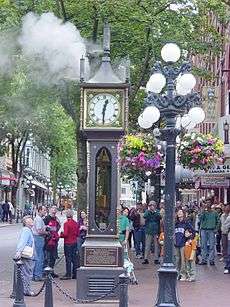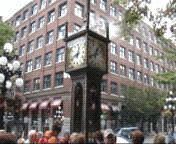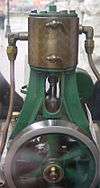Steam clock

A steam clock is a clock which is fully or partially powered by a steam engine. Only a few functioning steam clocks exist, most designed and built by Canadian horologist Raymond Saunders for display in urban public spaces. Steam clocks built by Saunders are located in Otaru, Japan; Indianapolis, United States; and the Canadian cities of Vancouver, Whistler and Port Coquitlam, all in British Columbia. Steam clocks by other makers are installed in St Helier, Jersey and at the Chelsea Farmers' Market in London, England.
Although they are often styled to appear as 19th-century antiques, steam clocks are a more recent phenomenon inspired by the Gastown steam clock built by Saunders in 1977. One exception is the steam clock built in the 19th century by Birmingham engineer John Inshaw to demonstrate the versatility of steam power.
Steam Clock Tavern
In 1859, the engineer and businessman John Inshaw took over the public house on the corner of Morville Street and Sherborne Street in Ladywood, Birmingham, UK. In a bid to make the establishment a talking point in the area, as well as furnishing it with various working models, Inshaw applied his interest in steam power to construct a steam-powered clock as a feature. A small boiler made steam; the steam condensed into droplets of water that fell on a plate at regular intervals, and the plate then drove the mechanism. The clock was installed above the door, and the pub became known as the Steam Clock Tavern. The establishment was sufficiently successful that it became a music hall in the 1880s.[1]
Gastown steam clock



Raymond Saunders' first steam clock was built in 1977 to solve the issue of a steam vent in a popular sidewalk for the renovated Gastown district of Vancouver, 49°17′04″N 123°06′32″W / 49.28444°N 123.10889°W.[2] Although the clock is now owned by the City of Vancouver, funding for the project, over $C58,000, was provided by contributions from local merchants, property owners, and private donors. Incorporating a steam engine and electric motors, the clock displays the time on four faces and announces the quarter hours with a whistle chime that plays the Westminster Quarters. The clock is featured on the cover for the 2011 Nickelback album Here and Now.
How it works
- Engine. The steam engine is a Stuart #4 single expansion double acting 1" piston engine purchased at the Stuart Turner Limited plant at Henley-on-Thames, England. (Engines of this size are typically employed by hobbyists for large model boat propulsion.) It is supplied with low pressure steam — engine inlet pressure is 17 psi (120 kPa) — from a centralized steam heating system that serves a portion of downtown Vancouver. The engine, rotating at only a few hundred revolutions per minute, drives a reduction gear train. The gear train drives an ascending chain lift to lift ball weights to a top track from which they load onto a drive chain providing the driving force to the clock while the ball weights descend.

- Chain lift. The engine-driven gear train drives the lower sprocket of a vertical link-chain (similar to a bicycle chain), with a lift of about four feet. Chain-mounted pairs of lifting fingers form forks which accept and lift smooth steel balls (about two inches in diameter). The balls are lifted at a rate of one every 4.5 minutes.
- Top transfer. A hammer-like mechanism operates to drive the topmost ball from the lifting fork at the top of the lift. The ball is then received by a transfer chute, whence it is routed to a gate at the top of the drive chain. The ball is restrained until a descending clock drive chain fork is properly positioned to receive it.
- Clock drive chain. A similar continuous chain receives the lifted balls from the transfer chute at the top of the mechanism. At any time, five or six balls are being carried by this chain. It is the unbalanced weight upon this chain that drives a conventional pendulum clock mechanism through the upper sprocket.
- Ball return. At the bottom of the clock drive chain the balls come to rest upon an inclined blade leading to a chute where they roll to the initial lifting point. Two or three of the balls are in this position, with the foremost awaiting the passage of the lifting fingers.
- Clock movement. The Gastown clock keeps time by a small tower clock movement that was custom-built in Croydon, England by Gillette & Johnston Co, from one of their 1875 designs. This type of tower clock movement was used in many small church tower clocks after 1875.

- Electric motors. The clock uses three electric motors. First, a small gear motor drives the tune playing machine. It rotates a drum with pins that play the Westminster chimes on micro switches which operate the steam whistle solenoid valves. Second, a small fan motor blows out hot air from the roof vent on top of the clock. Third, a small fan motor pulls warm air down to the base to provide air circulation.
- Chiming mechanism. Five steam whistles are mounted atop the clock case. The large central whistle, off the CPR steam tug Naramata, counts off the full hours. The four auxiliary whistles chime the Westminster Quarters four times an hour.
Other steam clocks
Indiana State Museum steam clock
The 17–foot–tall Indiana State Museum steam clock in Indianapolis, Indiana is located on the sidewalk on the north side of the museum. It has four 24" diameter dials that are back-lit by neon. The clock’s eight brass whistles play a few notes of "Back Home Again in Indiana" every 15 minutes. A more complete rendition is played at the top of every hour.
Chelsea Farmers' Market steam clock
The towering and quirky steam clock located at the Chelsea Farmers' Market was constructed in 1984. Although still standing, the clock is no longer in operation.
Jersey waterfront steamboat clock

The Jersey steam clock is a full-scale replica of the centre section of a paddle steamboat named the Ariadne. The clock was commissioned by the Jersey Waterfront Board in 1996, and built by Smith of Derby Group. Although once powered by steam, according to a Jersey government document "the steam workings have been replaced with electrical fittings designed to provide the same functionality including the blowing of 'steam' at the appropriate times of the day."
The clock is sited on the North Quay of the harbour at St Helier, Jersey, and also incorporates a fountain. It is listed in the Guinness Book of Records as the World's largest steam clock.
Berwick steam clock
Located at Berwick, Australia, 38°1′43.74″S 145°20′53.12″E / 38.0288167°S 145.3480889°E. Designed and built by Peter Weare at his own expense, it is a half scale prototype for a larger clock proposed for Melbourne Australia.[3] The clock was dismantled in December 2010 due to vandalism.[4] In December 2011, the City Council agreed to find a new site for the clock.[5]
See also
References
- ↑ Upton, Chris. "John Inshaw's Steam Clock". Digital Ladywood. Retrieved 17 September 2010.
- ↑ http://former.vancouver.ca/ctyclerk/cclerk//990311/pe2.htm
- ↑ Foster, Tony (8 November 2007). "Berwick steam clock". Retrieved 17 September 2010.
- ↑ http://pakenham.starcommunity.com.au/gazette/2011-09-07/clocks-time-runs-out/
- ↑ City of Casey, Minutes of the Council Meeting Tuesday 20 December 2011
External links
| Wikimedia Commons has media related to Steam clocks. |
- Handheld video of the Gastown steam clock chiming the hour.
- Chelsea Farmers' Market steam clock
- Youtube video (in German) showing the Westminster Chimes